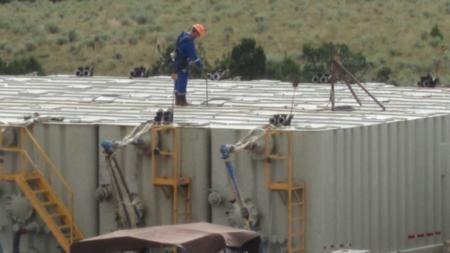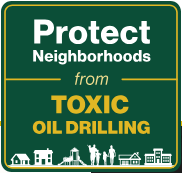Pro-Fracking Newspaper Ad Banned by Advertising Standards Authority
September 4, 2014Proposed Monaca, PA Chemical Plant Threatens Residents
September 18, 2014By Neela Banerjee, Los Angeles Times, September 11, 2014

Oil field technician gauging a flowback tank. Workers check such tanks several times an hour, during which many are exposed to potentially dangerous amounts of the carcinogen benzene. (NIOSH)
Some workers at oil and gas sites where fracking occurs are routinely exposed to high levels of benzene, a colorless gas that can cause cancer, according to a study by the National Institute for Occupational Safety and Health.
The agency, which is part of the Centers for Disease Control and Prevention, recommends that people limit their benzene exposure to an average of 0.1 of a part per million during their shift. But when NIOSH researchers measured the amount of airborne benzene that oil and gas workers were exposed to when they opened hatches atop tanks at well sites, 15 out of 17 samples were over that amount.
Workers must open these hatches to inspect the contents of these tanks, which could include oil, waste water or chemicals used in high-volume hydraulic fracturing, or fracking. The real-time readings taken by researchers show that benzene levels at the wells “reached concentrations that, depending on the length of exposure, potentially pose health risks for workers,” the researchers reported in the Journal of Occupational and Environmental Hygiene.
The study examined exposure risks for oil and gas workers during a phase of oil and gas extraction known as flowback. After a well is drilled in a tight geological formation such as shale and then hydraulically fractured to encourage the flow of hydrocarbons, fluids return up the well bore over the course of a month. The flowback contains fracking fluid, waste water, sand, oil and gas dissolved in water. The liquids are separated into constituent substances, including valuable fracking chemicals that can be reused, oil and gas that are stored in production tanks, and waste fluids that are held in flowback tanks.
Workers measure the volume of liquids in flowback and production tanks by opening top hatches and inserting so-called gauging sticks into flowback tanks. If the tanks are very deep, workers use hand-cranked gauging tapes to make their measurements.
Researchers visited six oil and gas sites in Colorado and Wyoming in the spring and summer of 2013, spending about two days at each site. They outfitted 16 workers at flowback tanks with small devices attached to their shirt collars that sampled the air throughout the day. The key measurements were taken when these workers were standing above the hatch.
Over the course of a 12-hour shift, workers open the hatches and stand above them one to four times per hour, breathing in the fumes for two to five minutes each time. This could add up to dangerous levels of exposure to various volatile organic compounds from the chemicals used in fracking, or from the hydrocarbons themselves.
Benzene, a component of crude oil, “is of major concern because it can be acutely toxic to the nervous system, liver, and kidneys at high concentrations,” the study authors wrote. As the CDC explains, benzene interferes with the normal workings of cells.
“It can cause bone marrow not to produce enough red blood cells, which can lead to anemia,” according to the CDC. “Also, it can damage the immune system by changing blood levels of antibodies and causing the loss of white blood cells.”
Although all but two of the samples recorded average daily benzene exposure above the NIOSH limit, the amounts were still below the far higher limit of 1 part per million set by the federal Occupational Safety and Health Administration.
Benzene, a component of crude oil, “is of major concern because it can be acutely toxic to the nervous system, liver, and kidneys at high concentrations,” the study authors wrote. As the CDC explains, benzene interferes with the normal workings of cells.
“It can cause bone marrow not to produce enough red blood cells, which can lead to anemia,” according to the CDC. “Also, it can damage the immune system by changing blood levels of antibodies and causing the loss of white blood cells.”
Although all but two of the samples recorded average daily benzene exposure above the NIOSH limit, the amounts were still below the far higher limit of 1 part per million set by the federal Occupational Safety and Health Administration.
NIOSH’s research on benzene is part of an ongoing project that it launched in 2005 to assess the scope and variety of chemical exposure risks for oil and gas workers at the extraction phase of industry. Much of the research on oil and gas development’s effects on worker health is from the 1980s and 1990s and doesn’t take into account new risks that workers might face amid an energy boom spreading through the country, driven by fracking.
“Industry has changed and is changing very rapidly,” Snawder said. “This is an updated base line of where we stand at this moment.”
The benzene study follows research NIOSH issued in 2012 indicating that workers were exposed to crystalline silica from sand used at fracking sites. Exposure to crystalline silica can lead to a deadly lung disease called silicosis, lung cancer and other respiratory ailments. OSHA is in the process of finalizing a new silica rule after years of delay, but its tougher standards are being fought by a range of industries.
Katie Brown, a spokeswoman with the trade group Energy In Depth, said that the oil and gas industry was committed to worker safety and had worked with NIOSH to allow them on well pads to test workers’ exposure risks.
The oil and gas sector also has fewer injuries than other industries, she said. “The number of nonfatal injuries and illnesses in the oil and gas industry has significantly declined while production has ramped up to unprecedented levels,” Brown said.
The oil and gas industry, however, has a fatality rate “of 27.5 per 100,000 workers (2003-2009) – more than seven times higher than the rate for all U.S. workers,” according to NIOSH. Most fatalities are the result of accidents.
“At least four workers have died since 2010 from what appears to be acute chemical exposures during flowback operations at well sites in the Williston Basin (North Dakota and Montana),” NIOSH reported on its blog.
The NIOSH scientists cautioned that the results of their new study were “preliminary,” given the small number of workers involved. But despite the limitations, they recommended comprehensive measures to address exposure to benzene, including the development of alternative tank gauging procedures to limit exposure and outfitting workers with respirators.
The breadth of the recommendations indicate how serious NIOSH believes the benzene threat to be, said Miriam Rotkin-Ellman, a health scientist with the Natural Resources Defense Council, which has spotlighted the enviornmental effects of fracking but is not opposed it altogether.
“Their recommendations are pretty pointed,” Rotkin-Ellman said. “They aren’t saying we need to study this issue at 15 more places before making these recommendations. These measures are warranted based on these investigations. You read their recommendations, and they say, ‘Get these people out of the way of benzene.’”



